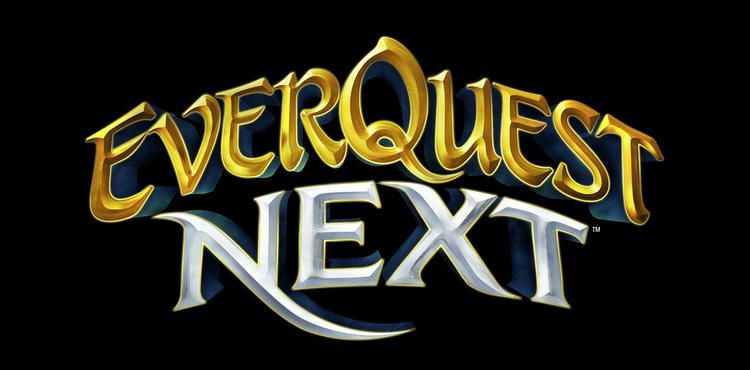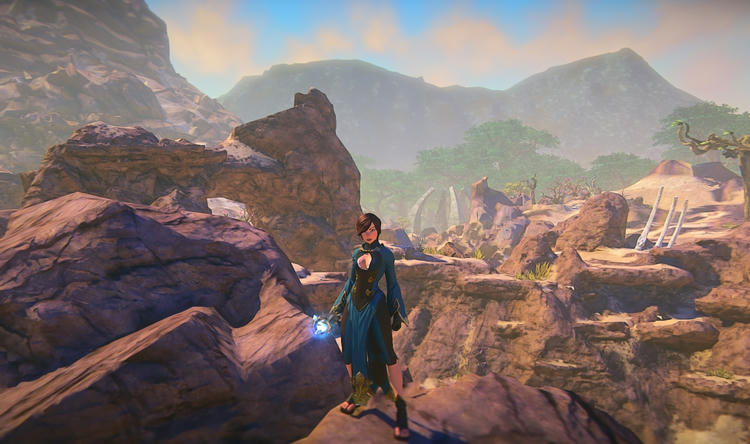
I'm writing this just a couple minutes after watching the EverQuest Next reveal video on Twitch. I couldn't watch it live yesterday, but it was totally worth the wait. For an hour and a half, I was on the edge of my chair. The introduction was a beautiful piece of sand performance art, which I otherwise won't talk about. The rest of the video was an introduction into what will probably be the single most revolutionary MMORPG to come out since 2003.
Dave Georgeson, director of development for EverQuest Next, started things off with a reveal of the art style. Let me tell you, this is a gorgeous game. The whole thing is very painterly, and is rendered using a modified version of the engine powering Planetside 2.
All of the races have been redone, and we were treated to concept art for several: the High Elf, the Dark Elf, the Human, the Dwarf, and the Kerran. The Dark Elf and the Kerran were probably the biggest departure from previous EQ designs. Kerrans are distinctly more lionesque, with pronounced lion's heads instead of the old cat faces and huge builds. Dark elves look like standard dark elves, except they have draconic eyes and short horns. There's a story behind that that I really want to hear.
The art style for characters is exaggerated, even slightly cartoony. I'm really OK with that, especially since they're building SOEmote into the game from the beginning. It's easy to see the expressions of the players themselves on their characters, and that's marvelous for a roleplayer, but also for immersion and socializing in general.

Movement is fantastic. Characters slide, leap, vault, grab, and otherwise interact with the terrain in a very natural way. With EQN's “active movement system,” players are free to really enjoy moving around in the world. There are items and spells that allow additional ways to move, like the Boots of the Zephyr in the video that allowed the players to float gently downward. Brilliant stuff.
Then, we got into the Four Grails, as Dave put it.
The Core Game
Grail 1 is the “Core Game.” This was the least impressive of the Grails, but it was still nice to see. Character evolution from a mechanical standpoint is based on collecting classes from around the world and mixing and matching abilities from them. It sounds like a hybrid of Guild Wars 2's system and Rift's system. Weapon choice matters, like it does in GW2.
Destructibility
Grail 2 is “Destructibility,” and this was the first mind-blowing revelation. The entire game world is built of voxels, despite looking natural and perfectly designed. It's fully destructible, even though it heals over time. It's like if SOE took a look at Minecraft and applied that on a grand scale. The way it works, too, is gorgeous. You can definitely see the aftermath of epic battles in the environment that it occurred in.
A Life of Consequence
Grail 3 is “A Life of Consequence.” Besides the standard “every action you take matters” spiel, we were introduced to the idea of emergent AI in an MMO. SOE will create mob behavioral patterns - likes, dislikes, etc. - and then release mobs of that type into the world. They will live, react, and die according to how they're programmed to behave. This means it's entirely possible to have roving bands of orcs that actually decide to set up camp in a particular area - choose their own spawn point, as it were. It's also possible to drive them out.
Permanent Change
Grail 4 is “Permanent Change.” For the most part, Dave talked about the Rallying Cry system, which is a little like a server-wide public quest that lasts 2-3 months each… and has permanent effect on the game world. These Rallying Cries are promised to be different on every server, and that along with the Life of Consequence and Destructibility Grails ensure that no two servers will have the same environment and history, let alone community.
EverQuest Next Landmark
As if all this wasn't enough, then they got into the EverQuest Next Landmark game that's coming out later in 2013. Landmark sounds basically like Minecraft on an epic scale, except that one continent in each Landmark server will have EverQuest Next art direction enforced… and creations from those areas will make it into EverQuest Next as real, lasting landmarks.
Player Studio
On top of that, SOE's Player Studio will find a very interesting real money economy implementation for people who enjoy building things in Landmark; you'll be able to sell not only finished works, but components. The example that Dave gave was of a player creating a nice crenelated tower. People could buy that tower, then make castles from it and sell those castles, and the player who created the tower would get royalties based on how many of that tower were used in the castle design for every castle sold. It's a fascinating system.
Basically, EverQuest Next sounds like the game I've been waiting for my entire gaming life. I really want to hear about how the crafting system works, and more about all the races, but… it sounds awe-inspiring. EverQuest Next takes player involvement in the game to a level never before seen.
Related articles
EverQuest Next - Landmark Focuses on Construction and Exploration, Is Free-to-Play
EverQuest Next + Jeremy Soule = Geek Delight
EverQuest Next Redefines Next-Gen MMOs Enhanced by Zemanta